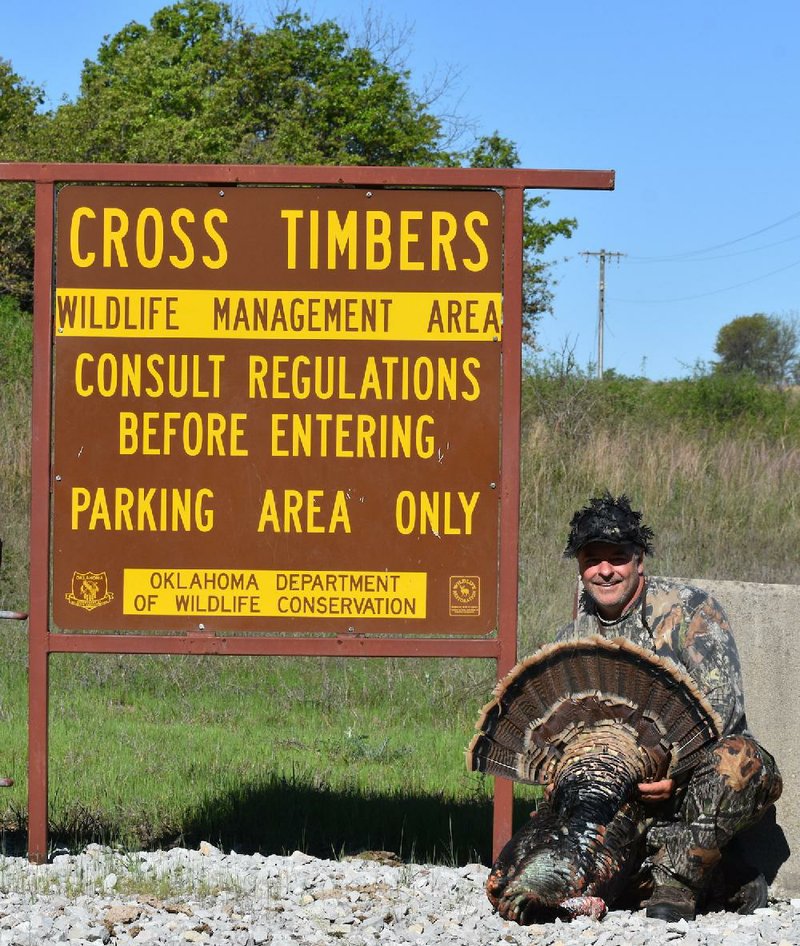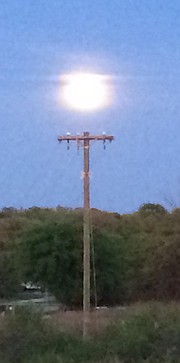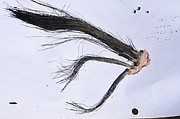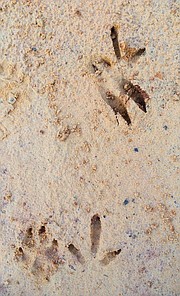BURNEYVILLE, Okla. -- My, what a hunt!
I killed my biggest gobbler Wednesday during a controlled hunt at Cross Timbers Wildlife Management Area in southern Oklahoma. The resplendent Rio Grande gobbler was my first triple bearded gobbler. The beards were 93/4, 61/4 and 51/2 inches long. The spurs were seven-eighths of an inch. The bird weighed a whopping 26 pounds.
After years of applying, I finally drew one of only 10 controlled hunt permits for Cross Timbers WMA, a 10,000-acre expanse of post oak/hickory woodlands in Love County near the Texas border.
Cross Timbers WMA is defined by gently rolling hills. Despite frequent use of controlled burning, the woods are very dense. A few small creeks flow through the area, and there are also ponds. The ODWC maintains vast amounts of food strips within the WMA for wildlife, and it also leases grazing rights to local cattle ranchers. Cattle disturb the soil and mimic the effect that buffalo once had when they roamed that country.
The hunt dates were April 8-12. I arrived on April 5 and claimed the best site in the WMA's designated campground. I brought my teardrop camper and a Yeti cooler full of food and drinks. I had 10 gallons of fresh water, milk, coffee and hot apple cider mix.
Despite walking many miles in three days, I ate very little and was satisfied.
On Monday, I met Zack Smith, the wildlife technician at Cross Timbers WMA. He told me about a big clover field near the area headquarters that attracts a lot of turkeys. He also told me about a gobbler that roosts on private property about 100 yards from the WMA boundary. He marked that bird's roost location on my map.
"You might be able to call that bird onto the area," Smith said.
At sunrise on Monday, I listened to a hot gobbler on a different part of the area about a mile from camp. At noon Monday, I visited the clover field. Three gobblers in a dense hollow that leads to the clover field gobbled nonstop. On the north end of the property I saw one hen. Coincidentally, that's where most of the other hunters concentrated.
At dawn on Tuesday, the clover field was quiet. That was clearly a midday option that I intended not to need.
On a hunch, my final scout-about was in a large, hard-to-access block on the west side of the WMA. Amid that block is a 160-acre inholding. Bordering the west side of the inholding is a long food strip that goes up two hillsides. One hillside is adjacent to the inholding. The other is opposite of the inholding.
At about 9:30 a.m., a gobbler bellowed atop the opposite hill. He gobbled continuously as he traveled through the woods atop the ridge. Beyond the crest he crossed the strip and continued gobbling on the other side.
"I'll bet he travels a little circuit every day, and there's not a soul back here to bother him," I thought.
Of the many miles I walked, I knew that was the spot. I've had that feeling in two other turkey hunts. Once was in western Oklahoma hunting with Glenn Clark of Vilonia. We came upon an empty blue plastic barrel in a hollow, and I told Clark that I was going to kill a turkey sitting against that barrel. And I did.
The other time was in 2016 at a controlled hunt at Madison County WMA. I found a spot that exuded such positivity that I left all my gear overnight, minus my gun, so that I couldn't talk myself out of it. I killed a mature gobbler there early the next morning.
[Gallery not loading above? Click here for more photos » arkansasonline.com/412hunt/]
I returned to camp and took a long nap. When I woke, it was nearly 100 degrees. I stuffed two decoys in a backpack and carried them up to the edge of the strip at the hill crest. I left the pack leaning against a tree and took a GPS reading so I could find it in the dark.
On the way back to the truck, I clocked the route. At a fast clip with no weight on my shoulders, it took 45 minutes. I imprinted every rut, every dip and every turn in the trail to memory so that I could retrace my steps in the dark. That was unnecessary because the pre-dawn moonlight was almost as bright as sunshine.
On Wednesday, I woke at 4:30 a.m. I brewed a mug full of coffee and began walking. I didn't need the GPS. I walked straight to my pack and placed the decoys in a woodland opening near the strip.
I am always such a basket case when I hunt in the mornings. No matter where I sit, that place over there is better. But what if a bird comes in from "X" direction? I need to be over there, instead. That place over gives a wider field of fire. Before long, I've bounced around to half a dozen setups. Finally, I forced myself to relax and let a gobbler dictate the terms of engagement.
I've learned that a lone gobbler often stops about 50-60 yards from decoys and displays. He expects hens to follow him. At about 7:45 a.m., I heard a faint gobble to the south. It sounded like the same bird I heard the day before. I moved 50 yards to the south, sat against a big tree and took out two Eddie Horton box calls, including one I call the Heirloom. It has a high, clear, sweet tone. The other is made of black walnut from Ouachita County with a bloodwood lid from Africa. It has a high, raspy tone. I picked them from a dozen Horton and Rhodes calls that I brought to camp because they sounded best in these woods.
I have been practicing a feed call consisting of a three-note whine followed by a short purr. I make that with a mouth diaphragm, but I had to try about a dozen models to get one with the right pitch. It's a very soft call for when a reticent gobbler is really close.
I worked the the two boxes and made a few cutts with the mouth call. The gobbler replied. A minute later, he gobbled again. It was a committed gobble, and he was closing fast.
Right about then I heard movement to the right. Eight large feral hogs had appeared about 20 yards away. I waved at them, and they stared. They finally ran when I lunged at them.
About one minute later, the tom gobbled again. He was close enough for the feed whine, to which he responded with a blaring, aggressive gobble. He came in running, but when he saw the decoys, he buried his heels in the dirt and skidded to a halt 50 yards away. He displayed, with his snood dangling well beneath his beak. When he turned to face me, the sunlight illuminated his fan.
Even though the gobbler was 50 yards from the decoys, he was only 20 yards from me. I blew a light cluck with my mouth call. The gobbler pulled in his feathers and faced me. At 8:05 a.m., it was done.
I stuffed the gobbler in my backpack and hoisted it onto my shoulders. I put the decoys in my hunting vest and slung it over one arm and carried the shotgun with the other arm. I took a shortcut through thick brush and high grass that cut off some distance, but it was definitely more work in the heat that was already above 80 degrees.
Even so, it was a very pleasant walk. A Cross Timbers WMA controlled hunt permit is a once-in-a-lifetime draw. I took my time and savored every step knowing I will never see this place again.
Sports on 04/12/2020



